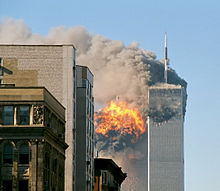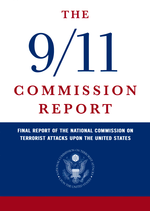- Orio Palmer
-
Orio Joseph Palmer Born Orio Joseph Palmer
March 2, 1956Died September 11, 2001
South Tower, 2 World Trade Center, New York CityCause of death Terrorism Residence Valley Stream, New York Other names Orio Education Associate's Degree (Electrical Technology) Alma mater Cardinal Spellman High School; Westchester Community College Occupation Battalion Chief, FDNY Battalion 7; Firefighter Employer Fire Department of New York Known for Lost his life while rescuing occupants of the World Trade Center on 9/11; first to reach the impact zone in 2 World Trade Center. Notable works Numerous papers and articles regarding Firefighting and Firefighter Safety; article(s) regarding Radio communications in High-rise building fires and use of repeaters to ensure communication while fighting High-rise building fires. Influenced Many. Home town Valley Stream, NY Television 9/11 (CBS); In Memoriam: New York City, 9/11/01 (HBO) Title Battalion Chief Spouse Debbie Palmer Children 3 (Dana, Keith and Alyssa) Call-sign Battalion 7 Awards Numerous Medals of Valor, Unit Citations Orio Joseph Palmer (March 2, 1956 – September 11, 2001) was a Battalion Chief of the New York City Fire Department who died while rescuing occupants of the World Trade Center on September 11, 2001.[1][2][3] Palmer led the team of firefighters that reached the 78th floor of the South Tower, the floor where the plane had struck the building.[1][2]
According to The 9/11 Commission Report, audio and video recordings prominently featuring Orio Palmer have played an important role in the ongoing analysis of problems with radio communications during the September 11 attacks.[4]
Contents
Family and education
Reporter Michael Daly wrote, "The 45-year-old Palmer was one of the department's rising stars, renowned for his smarts and nerve and decency, as well as his physical fitness."[2] He was married to Debbie Palmer, and had three children[3], Dana, Keith and Alyssa. [5] They lived in Valley Stream in Nassau County.
According to John Norman, Palmer was very fit and ran marathon races.[6] Historian Peter Charles Hoffer wrote that Palmer was "in superb condition". [7]
Palmer was one of the "most knowledgeable people in the department" about radio communication in high-rise fires. He graduated from Cardinal Spellman High School in New York City in 1974.[8] He "held an associate's degree in electrical technology, and had written a training article for the department on how to use repeaters to boost radio reception at high-rise fires."[9]
September 11
North Tower lobby
Footage of Palmer was used in the CBS film 9/11, and later in the HBO film In Memoriam: New York City, 9/11/01.[10] The video footage was shot by French documentary filmmakers Jules and Gedeon Naudet at the North Tower. It shows Palmer conferring with Deputy Chief Peter Hayden and Assistant Chief Donald Burns at the North Tower. The South Tower had just been hit. The men discuss how to respond to the two towers, and the communications problems they faced. The sound of a falling body hitting pavement outside reverberates. According to Michael Daly, "Palmer stood steady and calm, an air pack on his back, a red flashlight bound with black elastic to his white helmet, a radio in his left hand. His face showed only a readiness to do whatever was needed." The men decided that Burns and Palmer would proceed to the South Tower.[2]
Ascent of South Tower
 United Airlines Flight 175 strikes the 78th floor of the South Tower.
United Airlines Flight 175 strikes the 78th floor of the South Tower.
After arriving at the South Tower of the World Trade Center, Palmer and his men, accompanied by fire marshal Ronald Paul Bucca, took the one remaining operating elevator to the 44th floor sky deck, as high as it would go. According to John Norman, "It took almost 55 minutes after their arrival for Battalion Chief Orio Palmer and Fire Marshall Ronnie Bucca (both marathon runners) and members of Ladder Company 15 to ascend from the 44th floor to the 78th floor (where the plane impacted the South Tower)."[6]
When an audiotape of communication with the firefighters was released, it revealed that firefighters did not anticipate the building's collapse. Palmer, issuing an order to one of his subordinates, was recorded seconds before the building collapsed. Peter Charles Hoffer described Palmer's professionalism during the final moments of his life: "Listening to Palmer and his comrades on the recovered tape, one can hear the urgency of men working at high efficiency, but there was never a hint that the clock was running out on them."[7]
Transcripts of Palmer's last broadcast were published in 2002. The actual recordings were made public in 2005, as the result of a lawsuit filed by The New York Times and families of some of the firefighters killed on September 11. Monica Gabrielle of the Skyscraper Safety Campaign commented on the release of the tapes: "Today we are one step closer to learning what happened on 9/11 in NYC — where we excelled, where we failed."[11]
According to The Times of London, "Chief Palmer made it to the impact zone on the 78th floor of the south tower before the building collapsed. Once there the battalion chief reported 'Numerous 10–45s, Code Ones' — fire department code for dead people."
Palmer's brother-in-law, Jim McCaffrey, is also a firefighter, a Lieutenant in Ladder 31.[12] When new tapes were made public in 2006, his advice to family members was quoted, based on his family's experience first listening to the last recording of Palmer: "It was emotional sitting with my wife and sister-in-law, listening to the tapes. You're hearing him right at that point prior to the collapse, about the things he saw on the 78th floor. Before that, we didn't even know he got higher than the 40th floor."
Role in analysis of 9/11
In 2004, The 9/11 Commission Report relied on analysis of the North Tower lobby conversations between Palmer, Peter Hayden and Donald Burns in the film shot by Jules and Gedeon Naudet to better understand what was and was not working in the fire department's communications in those critical minutes. The report stated that, "Of particular concern to the chiefs—in light of FDNY difficulties in responding to the 1993 bombing—was communications capability. One of the chiefs recommended testing the repeater channel to see if it would work."[4] Peter Hayden, who survived, later testified, "People watching on TV certainly had more knowledge of what was happening a hundred floors above us than we did in the lobby.... [W]ithout critical information coming in... it's very difficult to make informed, critical decisions".[4]
The 9/11 Commission carefully analyzed the FDNY radio communications that day, and reported that the battalion chief (Palmer) was able to maintain radio communication that "worked well" with the senior chief in the lobby of the South Tower during the first fifteen minutes of his ascent. A message from a World Trade Center security official that the impact was on the 78th floor was relayed to Palmer, and he decided to try to take his team to that level. Beginning at 9:21 AM, Palmer was no longer able to reach the lobby command post, but his transmissions were recorded and analyzed later. He and his team reached the 78th floor sky lobby and were able to free a group of civilians trapped in an elevator at 9:58 AM. Palmer radioed that the area was open to the 79th floor, "well into the impact zone", and reported "numerous civilian fatalities in the area". One minute later, at 9:59 AM, the South Tower collapsed, killing everyone still inside. [4]
Michael Daly concluded that Palmer, "an uncommonly brave fire chief who was one of the department's most knowledgeable minds in communications perished never knowing of warnings telephoned by at least two callers less than 30 stories above him."[2]
Although they lost their lives themselves, Palmer and his crew had played an "indispensable role in ensuring calm in the stairwells, assisting the injured and guiding the evacuees on the lower floors."[13]
Legacy
At the National 9/11 Memorial, Palmer is memorialized at the South Pool, on Panel S-17.[14]
References
- ^ a b Kevin Flynn, Jim Dwyer (November 9, 2002). "Fire Department Tape Reveals No Awareness of Imminent Doom". New York Times. http://query.nytimes.com/gst/fullpage.html?res=9905EEDE1531F93AA35752C1A9649C8B63. Retrieved September 13, 2008. mirror
- ^ a b c d e Michael Daly (August 11, 2002). "His brave voice resounds". New York Daily News. http://www.nydailynews.com/archives/news/2002/08/11/2002-08-11_his_brave_voice_resounds.html. Retrieved September 13, 2008. mirror
- ^ a b Mai Tran (January 3, 2003). "A Week in West for 9/11 Firefighter Families". Los Angeles Times. http://articles.latimes.com/2003/jan/03/local/me-widows3. Retrieved September 28, 2008. mirror
- ^ a b c d Chair – Kean, Thomas H.; Vice Chair – Lee H. Hamilton (2004). The 9/11 Commission report: final report of the National Commission on Terrorist Attacks upon the United States. W. W. Norton & Company. pp. 298–304, 547–548. ISBN 9780393060416.
- ^ Palmer, Dana (January 29, 2002). "Orio Joseph Palmer: Letter to a Father". New York Times (New York). http://www.nytimes.com/2002/01/29/national/portraits/POG-29PALMER.html. Retrieved February 15, 2011.
- ^ a b Norman, John (2005). Fire Officer's Handbook of Tactics. PennWell Books. pp. 341. ISBN 9781593700614. http://books.google.com/books?id=VPxWmvKmzZkC&pg=PA341&dq=%22orio+palmer%22&hl=en&ei=aI9YTf7SFZS2sAPe2LyiDA&sa=X&oi=book_result&ct=result&resnum=1&ved=0CCYQ6AEwADgK#v=onepage&q=%22orio%20palmer%22&f=false.
- ^ a b Hoffer, Peter Charles (2006). Seven fires: the urban infernos that reshaped America. PublicAffairs. ISBN 9781586483555. http://books.google.com/books?id=enUjo5K9Q0IC&pg=PA336&dq=%22orio+palmer%22&hl=en&ei=iIlYTa2hDIO-sAP11KicDA&sa=X&oi=book_result&ct=result&resnum=4&ved=0CDYQ6AEwAw#v=onepage&q=%22orio%20palmer%22&f=false.
- ^ "Orio Palmer – Alumni Page". Cardinal Spellman H. S. – Class of 1974. http://spellman1974.doctorgeri.com/Orio.htm. Retrieved February 17, 2011.
- ^ Dwyer, Jim; Kevin Flynn (2006). 102 Minutes: The Untold Story of the Fight to Survive Inside the Twin Towers. Macmillan. ISBN 9780805080322. http://books.google.com/books?id=-Ctk6LxDDR8C&pg=PA61&dq=%22orio+palmer%22&hl=en&ei=PoVYTYKpA5K8sAOPtbGcDA&sa=X&oi=book_result&ct=result&resnum=2&ved=0CCwQ6AEwAQ#v=onepage&q=%22orio%20palmer%22&f=false.
- ^ Bill Egbert, Richard Weir, Bill Hutchinson (May 27, 2002). "9-11 film grips N.Y.ERS HBO documentary all too real for heroes". New York Daily News. http://www.nydailynews.com/archives/news/2002/05/27/2002-05-27_9-11_film_grips_n_y_ers_hbo_.html. Retrieved September 13, 2008. mirror
- ^ James Bone (August 13, 2005). "Voices of courage and terror resurrected by the 9/11 tapes: After four years, families of firefighters have forced release of radio messages". The Times. http://www.timesonline.co.uk/tol/news/world/us_and_americas/article554868.ece. Retrieved December 26, 2008. mirror
- ^ "CRIES FOR HELP. 9-11 KIN WILL RELIVE TRAGEDY VIA TAPE AS VICTIMS TRAPPED IN TOWERS DELIVER LAST PLEAS". New York Daily News. March 27, 2006. http://www.nydailynews.com/archives/news/2006/03/27/2006-03-27_cries_for_help__9-11_kin_wil.html. Retrieved September 28, 2008. mirror
- ^ Farmer, John (February 6, 2005). "A September Morning". Washington Post (Washington, DC). http://www.washingtonpost.com/wp-dyn/articles/A62073-2005Feb3.html. Retrieved February 14, 2011.
- ^ "South Pool: Panel S-17 - Orio Joseph Palmer". National September 11 Memorial & Museum. http://names.911memorial.org/#lang=en_US&page=person&id=4720. Retrieved October 29, 2011.
External links
- Debunking 911 Conspiracy Theories: The Fires – Orio Palmer, Deputy Chief, Battalion 7
- On Debunking 9/11 Debunking: Examining Dr. David Ray Griffin’s Latest Criticism of the NIST World Trade Center Investigation, by Ryan Mackey (Orio Palmer's observations are discussed on pages 26–27)
- Internet Archive – NY Fire Department's 9/11 Radio Dispatches
Categories:- 1956 births
- 2001 deaths
- New York City firefighters
- Victims of the September 11 attacks
Wikimedia Foundation. 2010.


